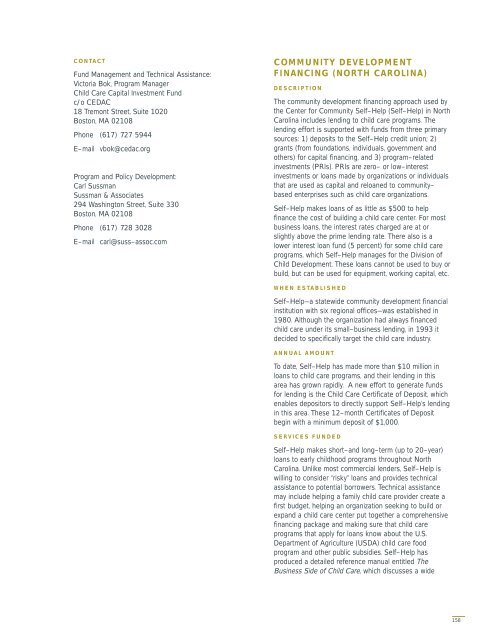Financing Child Care in the United States - Ewing Marion Kauffman ...
Financing Child Care in the United States - Ewing Marion Kauffman ...
Financing Child Care in the United States - Ewing Marion Kauffman ...
Create successful ePaper yourself
Turn your PDF publications into a flip-book with our unique Google optimized e-Paper software.
CONTACT<br />
Fund Management and Technical Assistance:<br />
Victoria Bok, Program Manager<br />
<strong>Child</strong> <strong>Care</strong> Capital Investment Fund<br />
c/o CEDAC<br />
18 Tremont Street, Suite 1020<br />
Boston, MA 02108<br />
Phone (617) 727 5944<br />
E–mail vbok@cedac.org<br />
Program and Policy Development:<br />
Carl Sussman<br />
Sussman & Associates<br />
294 Wash<strong>in</strong>gton Street, Suite 330<br />
Boston, MA 02108<br />
Phone (617) 728 3028<br />
E–mail carl@suss–assoc.com<br />
COMMUNITY DEVELOPMENT<br />
FINANCING (NORTH CAROLINA)<br />
DESCRIPTION<br />
The community development f<strong>in</strong>anc<strong>in</strong>g approach used by<br />
<strong>the</strong> Center for Community Self–Help (Self–Help) <strong>in</strong> North<br />
Carol<strong>in</strong>a <strong>in</strong>cludes lend<strong>in</strong>g to child care programs. The<br />
lend<strong>in</strong>g effort is supported with funds from three primary<br />
sources: 1) deposits to <strong>the</strong> Self–Help credit union; 2)<br />
grants (from foundations, <strong>in</strong>dividuals, government and<br />
o<strong>the</strong>rs) for capital f<strong>in</strong>anc<strong>in</strong>g, and 3) program–related<br />
<strong>in</strong>vestments (PRIs). PRIs are zero– or low–<strong>in</strong>terest<br />
<strong>in</strong>vestments or loans made by organizations or <strong>in</strong>dividuals<br />
that are used as capital and reloaned to community–<br />
based enterprises such as child care organizations.<br />
Self–Help makes loans of as little as $500 to help<br />
f<strong>in</strong>ance <strong>the</strong> cost of build<strong>in</strong>g a child care center. For most<br />
bus<strong>in</strong>ess loans, <strong>the</strong> <strong>in</strong>terest rates charged are at or<br />
slightly above <strong>the</strong> prime lend<strong>in</strong>g rate. There also is a<br />
lower <strong>in</strong>terest loan fund (5 percent) for some child care<br />
programs, which Self–Help manages for <strong>the</strong> Division of<br />
<strong>Child</strong> Development. These loans cannot be used to buy or<br />
build, but can be used for equipment, work<strong>in</strong>g capital, etc.<br />
WHEN ESTABLISHED<br />
Self–Help—a statewide community development f<strong>in</strong>ancial<br />
<strong>in</strong>stitution with six regional offices—was established <strong>in</strong><br />
1980. Although <strong>the</strong> organization had always f<strong>in</strong>anced<br />
child care under its small–bus<strong>in</strong>ess lend<strong>in</strong>g, <strong>in</strong> 1993 it<br />
decided to specifically target <strong>the</strong> child care <strong>in</strong>dustry.<br />
ANNUAL AMOUNT<br />
To date, Self–Help has made more than $10 million <strong>in</strong><br />
loans to child care programs, and <strong>the</strong>ir lend<strong>in</strong>g <strong>in</strong> this<br />
area has grown rapidly. A new effort to generate funds<br />
for lend<strong>in</strong>g is <strong>the</strong> <strong>Child</strong> <strong>Care</strong> Certificate of Deposit, which<br />
enables depositors to directly support Self–Help’s lend<strong>in</strong>g<br />
<strong>in</strong> this area. These 12–month Certificates of Deposit<br />
beg<strong>in</strong> with a m<strong>in</strong>imum deposit of $1,000.<br />
SERVICES FUNDED<br />
Self–Help makes short–and long–term (up to 20–year)<br />
loans to early childhood programs throughout North<br />
Carol<strong>in</strong>a. Unlike most commercial lenders, Self–Help is<br />
will<strong>in</strong>g to consider “risky” loans and provides technical<br />
assistance to potential borrowers. Technical assistance<br />
may <strong>in</strong>clude help<strong>in</strong>g a family child care provider create a<br />
first budget, help<strong>in</strong>g an organization seek<strong>in</strong>g to build or<br />
expand a child care center put toge<strong>the</strong>r a comprehensive<br />
f<strong>in</strong>anc<strong>in</strong>g package and mak<strong>in</strong>g sure that child care<br />
programs that apply for loans know about <strong>the</strong> U.S.<br />
Department of Agriculture (USDA) child care food<br />
program and o<strong>the</strong>r public subsidies. Self–Help has<br />
produced a detailed reference manual entitled The<br />
Bus<strong>in</strong>ess Side of <strong>Child</strong> <strong>Care</strong>, which discusses a wide<br />
158
















